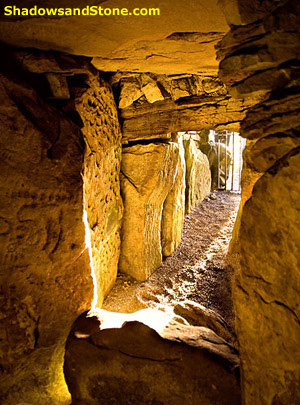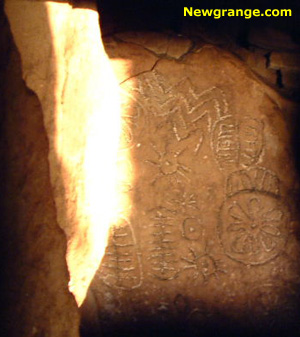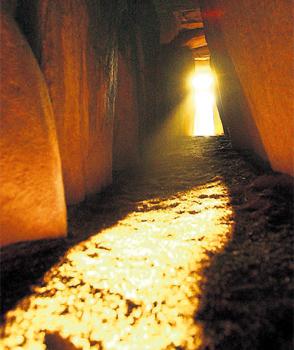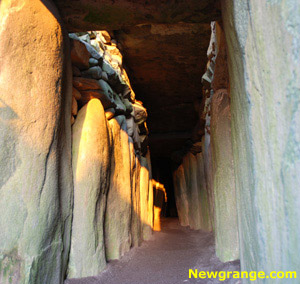Reflections on Loughcrew and Newgrange by Tim O'Brien
 We
came across the Cairns at Loughcrew in 1985 quite by accident and it was to
become one of the most exciting times of my life. Mary and I climbed the hill
with the late September evening, sun setting at our backs. As we walked over the
brow of the hill, Cairn T appeared like a mirage. It was just a large collection
of stones that appeared to be haphazardly put together. We went to the front of
the east side of the cairn and noticed that there was a gate left open.
We
came across the Cairns at Loughcrew in 1985 quite by accident and it was to
become one of the most exciting times of my life. Mary and I climbed the hill
with the late September evening, sun setting at our backs. As we walked over the
brow of the hill, Cairn T appeared like a mirage. It was just a large collection
of stones that appeared to be haphazardly put together. We went to the front of
the east side of the cairn and noticed that there was a gate left open.
It led to a passage into the pile of stones and we could hear voices inside. The people inside invited us in as they had a flashlight, which was necessary to observe the drawings on the stones. We had come to this place completely unaware of what to expect and were overwhelmed by what we saw within the chamber. Our unofficial guide gave us a quick tour pointing out the main features of the chamber and showed us the drawings that had been etched onto the stones both in the central chamber and the three small chambers off it.
There was some light entering the central chamber from a hole in the capstone above the chamber. It was a great pity that such a hole had been made as it allowed rain to enter the chamber. It may have been done with the best of intentions but it had allowed dampness into the chamber when it should have been as watertight as Newgrange.
I spent all my spare time over the next few months trying to find out everything that was known about Cairn T. I found out that the Cairns at Loughcrew were first described by Conwell in his book The Tomb of Ollamh Fodhla in the 19th century. A few years before his publication a paper on the Loughcrew cairns had been presented to the Architectural Society of Oxford.
However the first reference to the site is on a map prepared for the owner of the land in 1798. Conwell thought that the cairn we had visited (Cairn T) was a burial mound and this interpretation had persisted. There was very little written about the site but I came across another interpretation by Martin Brennan in his book The stars and the stones. He suggested that many of the cairns throughout the country were in fact implements to measure the movement of the sun and other celestial bodies. I was very impressed with some of his work but he made great leaps in his imagination to explain some of his ideas. For example I was not convinced that the pattern of light produced by the rising sun at the time of the Equinox in Cairn T would be quite as he suggested and I was determined to investigate this further.
We returned to the site with our family one afternoon in the middle of October and were much better prepared to explore. We had access to the key to open the gate and each of us had a flash light and proper attire. We noticed that there were many loose stones scattered on the ground, obviously thrown from the Cairn. We picked up a few of these and saw that they were quartz. These were most likely the original covering stones of the Cairn and would have given it a white appearance from a distance. What a spectacular sight this would have been. We placed as many of these stones back around the Cairn but all to no avail as they have since disappeared.
I was not convinced that Cairn T was a burial mound and I felt that it probably had more to do with trapping the sun at the time of the Equinoxes in mid March and mid September than interment. I planned to observe the rising sun on as many mornings as possible around the Equinox in March of the following year, 1986. This involved leaving Dublin around 5 am to travel to the site and climb the hill before sunrise. I met with a most enthusiastic man called Tom FitzGerald at the Office of Public Works who listened to my plans with great interest and facilitated me by providing a key to the site for the duration of my study. Regardless of the weather conditions I visited the site from March 13th to March 27th, 1986.
This first investigation was most enlightening. The sunrise was spectacular for ten days. I could see that the gate to the entrance blocked the sun’s rays as did the supporting stone and the concrete to the right of the gate. I photographed this interference to the beam of light, which was otherwise streaming down the passage into the central chamber and into to the back chamber as well. With the gate and its supports in place, it would be impossible to know exactly what the beam had been like when the structure was originally built. Armed with my photographs I made an appointment to meet up with Tom FitzGerald. He agreed that a new gate would be fitted and the supporting stone removed as it was not part of the original Cairn and this was done by July 1986.
I arranged to have the site surveyed by a friend called John Crowley. I knew a bit of basic astronomy and I understood that the sunrise position of the sun on the horizon would vary throughout the year. This was because the earth is tilted 23½ degrees to its plane of rotation around the sun. This is known as the obliquity of the ecliptic and results in our seasonal variation. Therefore in winter, on the shortest day of the year, referred to as the winter solstice, I knew that the sun would rise about 45 degrees south of east. The sun would not be able to shine into the central chamber of Cairn T. However after the solstice, the sun would rise each day a bit further north than the previous day and a day would come when the sun’s rays would shine into the central chamber in Cairn T.
When John was finished his survey, we placed his drawing on the stone called the Hag’s chair and compared them with the drawings in Conwell’s book. There were two obvious differences. Firstly, there was a sillstone missing in the passage since Conwell’s time and secondly, there was recent damage to the back stone in the end chamber, which was now missing a piece from its top left corner. I arranged to resume the observation of the site on the 13th of September, 1986. The weather forecast was good so the family decided to travel with me. We arrived at the Cairn well before sunrise and I covered the hole in the capstone with my coat. This made the central chamber a lot darker just as it was originally designed. We sat in the central chamber and waited.
 Suddenly
a beam of yellow light struck the big stone of the central
chamber to the left of the end chamber. This beam grew in size and moved to the
right onto the back stone in the end chamber. The central chamber was ablaze
with light, much more that I had imagined and then came the magical moment - the
beam on the back stone took on a rectangular shape, just as it had been designed
to do 5,000 years ago. I knew that we were witnessing something that had never
been described and probably had not been seen for 5,000 years. The left margin
of the beam was formed by a large stone in the passageway referred to as
Orthostat L3. The top margin was formed by the roof stone that this Orthostat
supported, and these were 5.4 metres away from the back stone in the end
chamber. The bottom margin was formed by the sillstone of the end chamber and
the right margin was formed by the stone of the entrance to the end chamber.
These stones were only one metre from the back stone.
Suddenly
a beam of yellow light struck the big stone of the central
chamber to the left of the end chamber. This beam grew in size and moved to the
right onto the back stone in the end chamber. The central chamber was ablaze
with light, much more that I had imagined and then came the magical moment - the
beam on the back stone took on a rectangular shape, just as it had been designed
to do 5,000 years ago. I knew that we were witnessing something that had never
been described and probably had not been seen for 5,000 years. The left margin
of the beam was formed by a large stone in the passageway referred to as
Orthostat L3. The top margin was formed by the roof stone that this Orthostat
supported, and these were 5.4 metres away from the back stone in the end
chamber. The bottom margin was formed by the sillstone of the end chamber and
the right margin was formed by the stone of the entrance to the end chamber.
These stones were only one metre from the back stone.
What happened then was that as the sun rose the rectangle of light decreased in size because the top and left margins moved at a faster rate, being formed by stones that were over 5 metres away, while the right and bottom margins barely moved as they were formed by stones only one metre away.
The effect was amazing and we sat spellbound as the rectangle diminished and eventually became only a spot of light, which then disappeared from the back stone. The sunbeam then could only be seen on the sillstone and the stone to the right of the end chamber. I had my photographs of the phenomenon and couldn’t be happier, having recorded this event for the first time. The weather over the next few days was exceptionally fine and I was able to photograph the change in the pattern of light over the next seven days. The weather broke on the 20th and there was no chance for photography during that Equinox.
I visited Tom FitzGerald in October 1986 and he was delighted with the photographic results. He introduced me to Paul McMahon, an engineer with a keen interest in the project and he provided me with an official letter stating that I was carrying out a four year study at the site so that I could show it to any person who queried my presence there. Tom invited myself and my wife to attend on the twenty first of December at Newgrange.
He wanted me to give an opinion on the phenomenon of the Winter solstice sun shining into the central chamber of Newgrange. This site is similar to Cairn T but it is on a much grander scale. The passage is about nineteen meters long compared to the six meters of Cairn T. As in Cairn T the passage leads into a central chamber with a magnificent corbelled roof which is eighteen feet tall. There are three side chambers but there are no sill stones which is in marked contrast to Cairn T.
 December
21st, 1986 was a perfect day for Newgrange. There wasn't a cloud in the
sky and it was chilly and crisp. There were about twenty people with official
passes and then there were the usual crowd of politicians who muscled their way
in among us. At four minutes after sunrise the beam of light struck the floor
and lit up the central chamber. The appearance of the sunbeam in the dark
chamber is undoubtedly spectacular and it was a great experience. The experience
at Loughcrew is very similar but on a much smaller and more intimate scale.
December
21st, 1986 was a perfect day for Newgrange. There wasn't a cloud in the
sky and it was chilly and crisp. There were about twenty people with official
passes and then there were the usual crowd of politicians who muscled their way
in among us. At four minutes after sunrise the beam of light struck the floor
and lit up the central chamber. The appearance of the sunbeam in the dark
chamber is undoubtedly spectacular and it was a great experience. The experience
at Loughcrew is very similar but on a much smaller and more intimate scale.
We made arrangements to carry out an up to date survey of Newgrange and to follow this up with a photographic study inside the Cairn at the time of the following year's Winter Solstice. This involved the placement of a camera on a fixed tripod over the central chamber so that it pointed down at the floor to record the position of the beam of light and we decided to place a clock on the floor to confirm the time in relation to the position of the beam. This camera was to provide still photographs of the light beam within the chamber. I suggested that we would also place a video camera in the chamber for the best part of four weeks around the Winter solstice and programme it to record for an hour each morning. Mr. FitzGerald agreed to all these plans.
Later in 1987 I made arrangements to video the Autumn Equinox at Loughcrew as the forecast was excellent. Judging from my previous observations at Loughcrew I expected that the eight-branch symbol on the right of the back stone (I called this symbol the Equinox symbol) would be illuminated by the rectangle of light at the equinox on the 22nd of September and I hoped to be able to see and photograph the phenomenon. September 22nd was cloudy but the 23rd was magnificent. I arrived early with a professional photographer and we were all set when the sun lit up the whole of the back stone. The rectangle of light gradually formed and after about 20 minutes it had focused on the Equinox symbol and just as predicted the beam illuminated this symbol perfectly. It was a brilliant moment and then gradually the beam faded away as usual. We were spellbound by the event.
I now had the evidence to formulate my ideas about why Cairn T had been built. I knew that the equinox symbol played a large part in the structure and its function. There were other symbols, two on the left and one above the equinox symbol itself that could be used to measure the daily change of the top of the beam of light. I knew that the equinox symbol was outlined precisely on the days close to the equinox. By extrapolating the data I had collected I was able to work out what would happen over a 4-year period and it was clear to me that Cairn T offered the possibility to define a four year cycle based on the changing patterns of illumination of the symbols on the back stone.
Following the Autumn Equinox of 1987 at Loughcrew, I now turned my attention to the Winter Solstice at Newgrange. The Office of Public Works was very helpful and supplied everything I asked for. The fixed camera with a wide angled lens was installed on a tripod with the camera pointing directly downwards. It was eight feet above the ground and viewed the whole of the central chamber. We also had a clock placed on the floor both as a time-keeper and to use as our marker for the beam. We planned to study the beam for about seven days and to use the unmanned video camera for a longer period. As Newgrange closed for Christmas there was no access after December 23rd and the days before the solstice were disappointing.
 I
was informed that there would be a special guest on the morning of the
Solstice, the Taoiseach, Charles J. Haughey.
There was a big crowd at the cairn with reporters from all the newspapers and also
television crew awaiting his arrival. In the central chamber I explained to him that the purpose of the study
was to record the phenomenon as it occurred today and then use our data to
figure out what might have happened 5,000 years ago.
Unfortunately as the sky was cloudy it seemed we might be disappointed and that
no light might appear in the chamber.
I
was informed that there would be a special guest on the morning of the
Solstice, the Taoiseach, Charles J. Haughey.
There was a big crowd at the cairn with reporters from all the newspapers and also
television crew awaiting his arrival. In the central chamber I explained to him that the purpose of the study
was to record the phenomenon as it occurred today and then use our data to
figure out what might have happened 5,000 years ago.
Unfortunately as the sky was cloudy it seemed we might be disappointed and that
no light might appear in the chamber.
While we waited the Taoiseach repeated what I had told him about the site to others present. He was the true politician and I didn’t mind him doing this. Indeed he asked people to cooperate with me by not interfering with any of the equipment in the now crowded area. Then just as we had given up hope, the sunbeam appeared on the ground four minutes after sunrise and a great roar went up inside the chamber. Haughey said when the roar subsided “I told you I had the power”.
Despite the poor weather there was sufficient photographic material from the video recordings and photos of the light entering the chamber at Newgrange to build up a pattern of the events before, during and after the Winter Solstice. I received a plan of the new survey of Newgrange from the Office of Public Works in early 1988 and I set about analysing the data gathered on site with their detailed ground plan. I started by concentrating on the beam of light in the central chamber.
I noticed from my photographs that it was in a different position each day. As the solstice approached the beam of light seemed to penetrate further each day, beginning on the left and ending on the right. However after the solstice the beam withdrew from the furthest point of entry and penetrated the central chamber less each day until it eventually failed to enter the central chamber at all. I thought that this pattern of light penetration into the central chamber on the days around the Winter Solstice might explain the decoration on the front kerbstone which shows the spiral decreasing in a clockwise direction on the left and increasing on the right.
After the winter study at Newgrange I collected the videos from the OPW and when I was finished viewing them I presented my work to the Office of Public Works. Both Tom FitzGerald and Paul McMahon had left and there was not as much interest in the project by the new people. However I presented my conclusions:
- That when Newgrange was built the sun would have penetrated into the end chamber and on the day of the winter Solstice it would have struck the back stone.
- Today because of a change in the tilt of the earth the sun only penetrates into the Central chamber.
- The pattern of the beam on the floor of the central chamber is graphically represented by the change of direction of the spirals on the stones around the site, for example, the beam increases in a clockwise direction before the solstice and decreases in a clockwise direction after the solstice.
- The beam remains in the chamber from many more days than was imagined. For example the video from the 29th of December shows that the sun penetrated into the central chamber at about four minutes past nine and remained on the floor of the chamber for about five minutes. This was the final time that we recorded the beam, however we calculated from the survey that it was likely that the beam would enter the chamber for another few days. This means that with clear weather conditions the beam enters the chamber for at least a fortnight on either side of the solstice.
- It would be possible (though probably undesirable) to reproduce the original path of the beam, allowing it to strike the back stone as originally designed, by lowering the floor of the central and end chambers by a certain amount.
Boyne Valley Private Day Tour
 Immerse yourself in the rich heritage and culture of the Boyne Valley with our full-day private tours.
Visit Newgrange World Heritage site, explore the Hill of Slane, where Saint Patrick famously lit the Paschal fire.
Discover the Hill of Tara, the ancient seat of power for the High Kings of Ireland.
Book Now
Immerse yourself in the rich heritage and culture of the Boyne Valley with our full-day private tours.
Visit Newgrange World Heritage site, explore the Hill of Slane, where Saint Patrick famously lit the Paschal fire.
Discover the Hill of Tara, the ancient seat of power for the High Kings of Ireland.
Book Now
Home
| Visitor Centre
| Tours
| Winter Solstice
| Solstice Lottery
| Images
| Local Area
| News
| Knowth
| Dowth
| Articles
| Art
| Books
| Directions
| Accommodation
| Contact
